'We planted trees among the rubble': The dark WW2 history written into Germany's parks
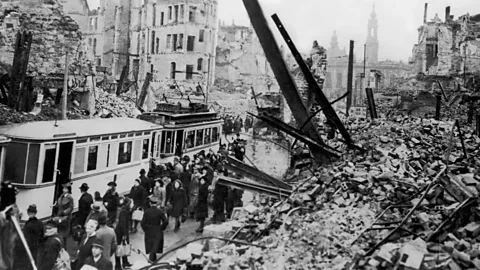 Getty Images
Getty ImagesEighty years after the end of World War Two, blasted trees and rubble forests tell a hidden story of wartime bombardment and Nazi terror.
In the early 1950s, Rudolf Schröder, a young gardener, led a group of apprentices through the abandoned plots of bombed houses in post-war Dresden. Their quest: to find tree saplings for planting along the city's streets. Dresden was still ravaged by the firebombing in February 1945 that killed tens of thousands of civilians. But slowly, here and in other cities across Germany, survivors were starting a green recovery.
"We searched the ruins of buildings with gardens for saplings and found lots of them – linden trees, maple, oak. We dug them up, and planted the best ones along the streets," recalls Schröder, who was born in 1933, speaking from his home in Dresden. "It was a hard time, but we were full of hope."
Saplings were hard to find as so many trees in public parks had been destroyed, and had to be replaced with stock from nurseries outside of the bombed city. It was when those nurseries ran out that Schröder and his friends resorted to the abandoned gardens – where many saplings had sprung up as the plots were left untended. There were enough young trees for some to be taken and replanted along the streets to cheer up the public, and others to be left in place, according to Schröder. Today, some of those rubble-sourced street trees planted by Schröder and his team still stand, for example along the Krenkelstraße street in Dresden, he says.
Eighty years after the end of World War Two and the fall of the Nazi regime, many of Germany's urban trees and green spaces still hold such hidden traces of the past. In post-war Berlin, rare plants suddenly thrived in bombed wastelands, and urban forests sprung up in the rubble. Forest also grew over abandoned Jewish graves, as the Jewish families that had tended those graves were deported and murdered in the Holocaust. Some bomb-scarred trees, and post-war rubble forests, have been turned into memorials and nature sanctuaries.
And in some cases, like that of Dresden's botanical garden and the adjacent Großer Garten (Great Garden) park, a lush green area holds a dark story from the intensifying Nazi terror to the war and its aftermath – giving insights into nature's surprising role as a witness and archive of human history, to this day.
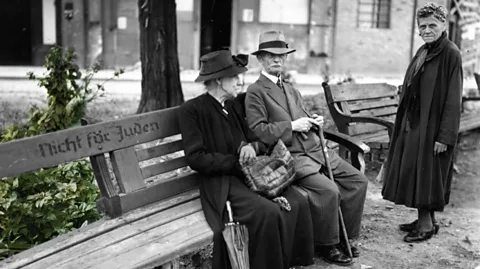 Botanical Garden, Dresden/ BBC
Botanical Garden, Dresden/ BBC'No Jews allowed': Green spaces and Nazi repression
"A new ban for Jews, from entering the Great Garden and other parks," wrote Victor Klemperer, a Jewish literary scholar in Dresden, in his secret diary in July 1940. Repeated across parks and botanical gardens all over Germany, the ban was one of many Nazi measures against Jews in the run-up to the Holocaust. Klemperer explained in his diary that the park ban was especially powerful as Jews already had almost nowhere to go in 1940s Germany: the Klemperers and others had been excluded from jobs, universities, schools and libraries, removed from their homes and put into communal housing with other Jews, and placed under a curfew. Having lost their own home and garden, Klemperer and his non-Jewish wife, Eva, bought flowerpots for their balcony to at least have the comfort of some greenery, as they nervously observed the increasing arrests and deportations of their friends and neighbours.
While the fact that Jews were banned from parks and other green spaces during the Nazi era is generally known in Germany, there is relatively little research on the subject. However, garden historian Joachim Wolschke-Bulmahn argues in a book chapter on green spaces and antisemitic persecution in the Nazi era, that the park bans played an important role in the terror. He notes that the bans also show just how actively some ordinary people participated in the persecution. In cities such as Leipzig, Bremen, Berlin and Hannover, non-Jewish Germans denounced Jewish park visitors to Nazi authorities and helped implement the bans, he and others note. Individual cities took the initiative of banning Jews from benches and parks.
"The Nazi dictatorship relied on the voluntary support of many Germans in order to function," Wolschke-Bulmahn writes. He also points out that this aspect of the Nazi era is generally omitted from official histories of these parks.
Two archived letters from Dresden's botanical garden, provided by staff there, illustrate how meticulously the bans were pursued. "It has been observed that Jews are using the botanical garden," a Nazi party official wrote to the garden's director in 1941, demanding that this be stopped and a sign put up with a ban. The director replied, saying Jews had now been banned from the garden, and that a sign had been put up.
The persecution ultimately affected every part of the botanical and gardening world across Germany, from parks to research departments, as Jewish-German botanists and horticulture students were exiled or murdered.
Victor and Eva Klemperer survived the war, even as others around them were deported to the death camps. When the Allied firebombing of Dresden began on 13 February 1945, the couple sensed their chance. Amid the chaos and destruction, Eva removed Victor's yellow star from his coat with a pocketknife, to hide his Jewish identity, and they fled the city and hid until Germany surrendered.
At the Weissensee Cemetery in Berlin, one of Europe's largest Jewish cemeteries, a patch of wild urban forest has been left standing as a memorial to the Holocaust. During the Nazi era, most of Berlin's Jews emigrated or were murdered. As a result, few people were left to tend the graves and the cemetery became overgrown, says Ingo Kowarik, a retired professor for ecosystem science and plant ecology at the Technical University Berlin. In 2016, he and his colleagues documented 604 species of plants and animals in the cemetery.
"Forests grow everywhere, including in the city. And on this cemetery, a forest has been growing since the post-war era," says Kowarik. While parts of the cemetery have been restored, and some growth cleared from the graves, many trees stayed. "Some of the graves were restored along with the woodland around them, because this woodland is a reminder of the Holocaust," he says.
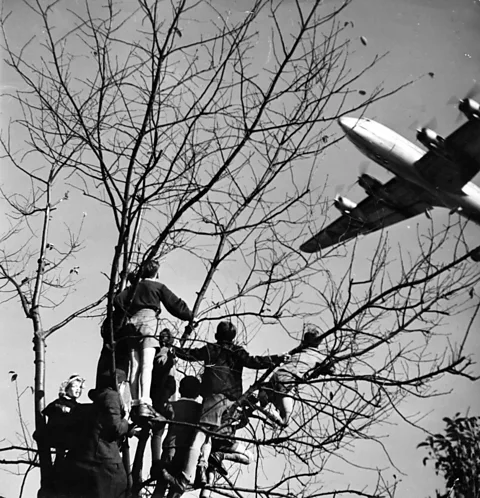 Getty Images
Getty ImagesTrees in the rubble
For Rudolf Schröder, Dresden's botanical garden offered a place of respite during his wartime childhood. In 1943, his father was briefly home from the war and took 10-year-old Rudolf on a visit there. "We went to the big palm house. It was nice and warm, heated with coal, which was special in that wartime winter," he recalls.
Two years later, when the Allied bombs began to hit Dresden, the city's public gardens initially seemed to offer safety. "Our mother decided that it would be safest in the Great Garden... We sat huddled together under a big oak in the park... Astonished, we watched the houses burn," wrote a survivor of the bombing, who was eight years old at the time and whose father worked in the botanical garden, in a document provided by the garden. More bombs followed the next day, shattering the palm house and leaving craters in the park
Schröder also survived the firebombing. But his father never returned from the war. "That was very painful for me, because we were very close," he says. "He taught me a lot about plants, and we would use a microscope together. He was passionate about biology."
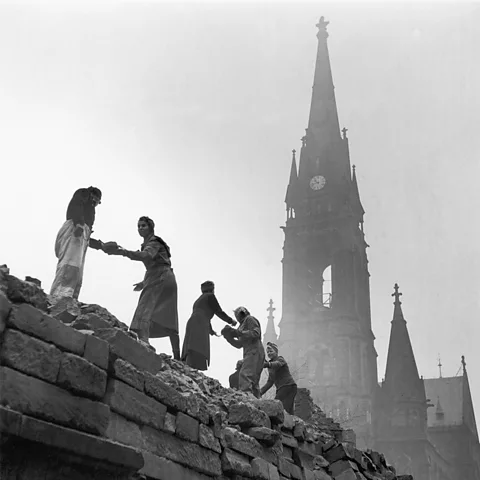 Getty Images
Getty ImagesAfter the war, the Great Garden was turned into vegetable plots, and Schröder, still a schoolboy, planted corn and beans to feed his family. Later, as a teenager, he trained as a gardener and helped clear and replant the Great Garden.
"One day we were standing around an oak that was almost completely blasted by a bomb, and our boss asked, shall we cut it down?" he says of those post-war years. "But then we walked around to its other side and we saw that on that side, it was still alive and green."
They decided to let the oak stay. "And it still stands today. One side is dead, the other is alive. It's beset by many different fungi, but it still has so much vitality," says Schröder.
Known as the Splittereiche, "splinter-oak", the tree is preserved in the Great Garden as a monument. Schröder later became the director of the botanical garden, and continues to visit it now that he is retired.
Replanting urban forests
Joe McBride, a professor emeritus of landscape architecture and environmental planning at University of California, Berkeley, interviewed Schröder and other gardeners, arborists and botanists in war-torn cities around the world, to study the reconstruction of urban forests destroyed by conflict.
"I found people like that all over the world, in Dresden, in Hiroshima, in spite of the fact that their cities were in ruins, they really had dedicated themselves to planting these trees," he says. Often these people had been professional arborists before the war, he says, "but private citizens also made an effort to plant, to get the trees started, to replant the environment they had grown up in as children".
Often, the cities' trees had been decimated by bombings and the need for firewood after the war, and tree nurseries were empty, forcing people to be resourceful. In Hiroshima, for example, local farmers donated trees to plant after the city's devastation by the atomic bomb, he says, and the city also conserved trees that survived the bomb.
One pattern McBride found across these destroyed cities was that trees provided the survivors with hope. "People needed to recover psychologically as well as physically, they wanted that apple tree in their backyard, and that linden tree in front of their house – to leave the war behind them, and have nothing remind them of the horrors," he says of Dresden and Hamburg, two bombed German cities he studied together with Judith Stilgenbauer of the University of Hawaii.
Green life in Berlin's 'dead eye'
In Berlin, that post-war recovery took a very different turn. Its ecosystems reflect its dramatic history as a city that was bombed, and then, divided at the end of World War Two. The US, Britain and France occupied West Berlin; the Soviet Union controlled East Berlin. The fate of the city soon became embroiled in the rising tensions between the former allies, a chapter that ended with the fall of the Berlin Wall on 9 Nov 1989.
"In Berlin, you do still see war damage on individual trees, for example, there are old oaks in Tiergarten with partly destroyed crowns and other injuries. It's an analogy to the famous bullet holes you still see in facades in Berlin," says the Technical University Berlin's Kowarik, who has studied the city's ecosystems for decades. "However, the much, much more obvious impact of the war on Berlin's ecosystem is the destruction of wide parts of the inner city, the so-called 'dead eye' of Berlin, where more than half of the buildings were destroyed," he says.
In other German cities, such wasteland was quickly rebuilt, but in Berlin, the division – which left West Berlin as an island within the East, with a wall around it – stalled such development, Kowarik points out. In the 1970s, long after the end of the war, urban ecologists documented the plants growing in those wastelands.
"It was the beginning of an accidental large-scale experiment: the return of nature to areas that had been completely reshaped by humans," he says.
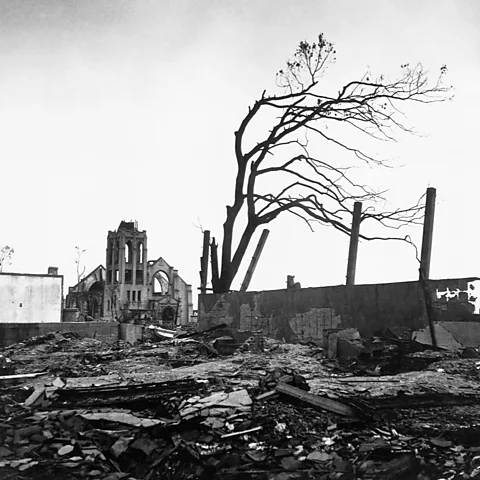 Getty Images
Getty ImagesWaves of recovery
Some plants that had previously been rare in Berlin, found a perfect habitat in the city's rubble. One of them was a plant known as sticky goosefoot, which is native to dried-out riverbeds in the eastern Mediterranean, Kowarik says. It was cultivated in Berlin as a very rare garden plant. "After the war, it expanded massively. There are old pictures of Potsdamer Platz [a central, iconic square in Berlin] when it was empty, and it's almost entirely covered by this plant," he says. "Today, because the city has been developed again, that plant has again become very rare."
However, he adds that it sometimes still germinates when the ground is disturbed during building works: "It emerges from the seed stored in the soil, like a greeting from the post-war vegetation."
Pennsylvania pellitory (Parietaria pensylvanica) is a another plant that colonised post-war Berlin. It was previously cultivated in Berlin's botanical garden and is thought to have spread when its seeds were blasted across the city in one of the bombings, Kowarik says, referring to these plants as Trümmervegetation, "rubble vegetation". Over time, those pioneer plants were then overtaken by shrubs and trees, a pattern of ecological succession seen both inside and outside of cities, he says.
"You see this succession in a lot of places in Berlin," he says, culminating in urban wild forest. In one area, the Schöneberger Südgelände, such a wild forest has been preserved for the public, as a nature reserve with accessible paths and artworks, he says: "You have to show people that these wild forests are something special that has to do with the history of the city."
In some green spaces in Berlin, military relics from the Nazi era, such as bunkers and anti-aircraft towers (known as flak towers), remain and have become refuges for species such as bats.
Other cities hastily covered up all traces of the war. In Hamburg, planners hoped that newly created green spaces such as the Alsterpark would help the city return to normal life, says Eliane Schmid, a doctoral researcher at the Luxembourg Centre for Contemporary and Digital History.
"What you see very clearly with Hamburg [in the first decades after World War Two] is this idea of just skipping the Nazi era," she says. "It's this idea of, 'the Nazi era was a misfortune that we slid into, and now we're a green city again, and a portal to the world'." One of the city's first post-war initiatives was to put flowers on balconies around the main station, so visitors would feel welcome in Hamburg, she says.
Schröder, who planted those tree saplings in Dresden after the war, still regularly inspects the trees in the botanical garden, and examines their health. Lately, he has been worrying about the impact of climate change on them, he says, as he has noticed signs of stress from dry, hot periods, leaving the trees vulnerable to pests and fungi. He also likes to visit the Great Garden, where he and his friends once left that blasted oak, the Splittereiche, standing. Sounding contemplative, he says: "When I'm there, I go to the Splittereiche. I look at its wounds."
--
For essential climate news and hopeful developments to your inbox, sign up to the Future Earth newsletter, while The Essential List delivers a handpicked selection of features and insights twice a week.
